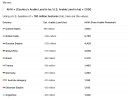I didn't play very much pre-1.9, not sure what the values used to be, I just know them as they are now, and here's what I experienced:
Played a game as Russia, trying to make the most possible use of the plentiful starting population.
-10% mortality from food standardization, -20% from going for public hospitals (4) very quickly
+5% fertility from legal guardianship, +5% fertility from a very happy clergy, +5% from the grocery company, which made for my first company pick.
I ended up with population growth in the area of +2.75% a year. I closed my borders to prevent the outflow of people, which I gauged to be a greater possibility than any inflow.
It's April 1867, I have 131.5 million people and millions of unemployed laborers. My subsistence farms just spit them out once they're full, and there's little I can do (for lack of construction capability) to get them out of destitution. My subsistence farms are at 16.9m/19.9m occupancy.
I found a lot of discourse around what arable land is supposed to represent. Some say the US (at roughly 150% of what Russia has) was buffed to simulate migration and it corresponds to exploited resources as much as to potential resources and so on.
I can't judge these cases. I'm no agricultural historian. But if some balance consideration played into those values, and if population growth has been adjusted while arable land hasn't, aren't these values now totally out of whack?
Played a game as Russia, trying to make the most possible use of the plentiful starting population.
-10% mortality from food standardization, -20% from going for public hospitals (4) very quickly
+5% fertility from legal guardianship, +5% fertility from a very happy clergy, +5% from the grocery company, which made for my first company pick.
I ended up with population growth in the area of +2.75% a year. I closed my borders to prevent the outflow of people, which I gauged to be a greater possibility than any inflow.
It's April 1867, I have 131.5 million people and millions of unemployed laborers. My subsistence farms just spit them out once they're full, and there's little I can do (for lack of construction capability) to get them out of destitution. My subsistence farms are at 16.9m/19.9m occupancy.
I found a lot of discourse around what arable land is supposed to represent. Some say the US (at roughly 150% of what Russia has) was buffed to simulate migration and it corresponds to exploited resources as much as to potential resources and so on.
I can't judge these cases. I'm no agricultural historian. But if some balance consideration played into those values, and if population growth has been adjusted while arable land hasn't, aren't these values now totally out of whack?
- 1


